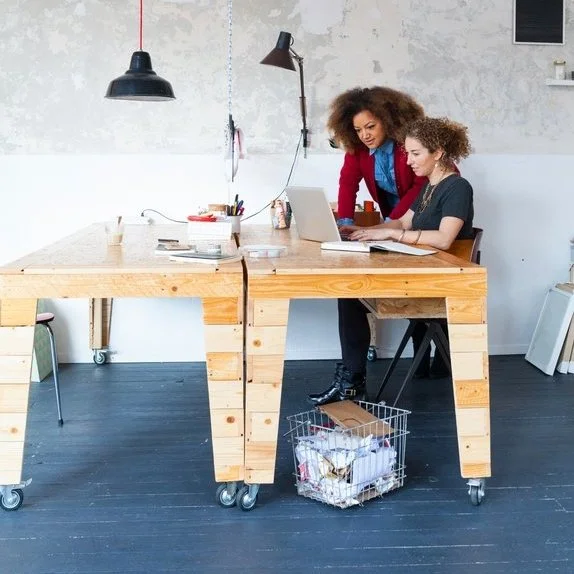The Modern Office
THE MODERN OFFICE: WORKING INDEPENDENTLY AND COLLABORATIVELY WITH EASE
The Modern Office is not just about the people. It is also how the people work in the spaces they are provided.
We already know the impact of the quality of a space and working conditions contributes to the overall well-being and safety of the workers. It is also about embracing how work culture is shifting in many professional environments.
I have a sincere appreciation for the aesthetics of a space. However, design in the modern office is also about creating spaces that embrace the ease of moving from independent work to collaborative work throughout the day.
Research studies show that work is highly fragmented. We are frequently moving from one task to another. According to a Knoll study on holistic workspace solutions, we are changing tasks every 11 minutes, and once we switch, we will complete 2 more tasks before we go back to the original task (O'Neill & Albin, 2011).
This sounds familiar to me—not just at work, but at home, too! Just in the last hour, I did the following activities while I was writing:
Write
Go get coffee.
Come back to writing.
Take a phone call.
Load the dishwasher.
Make a smoothie.
Help the kids get something to eat.
Go back to writing.
Check in and make sure everyone is working well and no one is hurting each other.
Help out with whatever is needed at the time (He took her spot on the carpet, and I have to mediate).
Go back to writing.
Live scene shown here of me checking in to make sure everyone is ok . . .Don't worry. All safe.
Let’s see how long I can keep this momentum going before I have to intervene in anything. Now, I do need some time to focus and write, but I also find myself moving on even when everyone is around because the noise is normal in my world, and I feel connected in some way to those around me, taking all the surroundings and environment into consideration. It was OK for me to have “mini-breaks” so I can just get up and move around, as well as make sure that I am attending to the needs of those around me, not getting stuck in my own world.
I also have times where I clearly need to be alone and reflect and get things done. In this case, I go away to an office or quiet workspace. So, everyone experiences their needs and their optimum work style in a different way at different times.
While it is important to recognize how we move so quickly from one task to another, and need just as much personal space and down time, I am surprised to learn some facts and statistics that drive the changes in the modern office.
For now, based on O’Neill & Albin’s research, we will focus on two factors as it relates to our modern office:
Women form the majority of professional workers.
Companies are in a “war for talent” for business success:
Key jobs depend on a complex set of skills: problem solving, judgment, listening, data analysis, relationship building, mobility and many forms of formal and informal collaboration.
Let’s consider the impact of the above for workplace strategies.
We must keep a pulse on the needs of the working community if we are to go to combat in this war for talent (regardless of male, female, single, married, family and so on), as well as taking considerations for women in the workplace.
One key to this is Flexibility. This is not just a women’s issue, or even a mother’s issue anymore. This is the way of the world. Technology has allowed us to work remotely where we are and when we want.
For example, my office tonight is on my lower level sofa: research books, coffee, snacks, tablet, cell phone, and laptop all here with me. On Sunday, I connected to email and did research during the waiting periods at my daughter’s gymnastics meet. You may find a cozy spot to work that makes you feel like you can still be comfortable, while being in the mode of getting some things done.
I work in a traditional office setting during most of the week, but work out of our production facility once a week. While it is true that some jobs cannot be done remotely, that doesn’t mean flexibility is not still just as important. We can get creative with how we approach our design.
Here are a few more facts to consider (O'Neill & Albin, 2011):
Almost half all work occurs outside the primary workspace.
About a quarter of work happens at other locations in the building or campus.
About a quarter of work occurs at other locations within, or outside, the community.
This range of locations varies depending on industry.
Flexibility is about how people work during the day—start and stop times, how they organize their day, where they sit or how they get quiet time and collaborative time. Many workers desire more flexibility, or at least want to be provided with choices in how they work. With a rising entrepreneurial spirit and change in the marketplace because of technology, retaining workers will become much more challenging.
As women, thriving and flourishing includes our surroundings and how we work in a space. It is also having the ability to leave the office for a game, a doctor appointment, or dinner at home with the family without having the “guilt” factor at work. And, then, maybe going back to work after we put the kids to bed.
By embracing a creative approach to work style, it forces us more into a community, as it requires us to lean on those around us to be capable of performing well in our absence, as well as giving them “permission” to respond with the same freedom. This is the dance of collaboration, community, and independence. It takes coordination, empowered teams, and leaders who embrace the new working environment.
Success in space planning considers this range of activities: the actual job being done, the need for quiet space and meeting spaces, understanding the needs of those working in the environment, and taking an active role in understanding that work is now frequently being done remotely. There are still some challenges with this, though, as we continually have to balance productivity with embracing community and collaboration.
O’Neill & Albin go further in their research to reveal the disconnects of the current workspace designs:
There is a “facility disconnect”—collaborative work is viewed as having the biggest impact on business success—but organizations make the least investment in group space.
“Heads down” work makes an important, but relatively lower contribution to business effectiveness, than collaborative work.
While individual spaces will continue to play an important and enduring role, we found an under-investment in collaborative workspaces.
SO, NOW WHAT DOES ALL THIS MEAN FOR ME?
As leaders or change agents in an organization, embracing collaboration can be difficult because it feels like letting go of productivity. Creating a space that brings people together doesn’t always feel like it makes sense in the quest to make things happen. It may feel like it will take up more time, impair us from checking off the lists, and encourage too much conversation. I am still personally challenged with the productivity vs. collaboration mentality (which we often view as “not being productive”) in my leadership. It just seems like it will take less time if we all have our own spaces, get things done on my to-do list, and tell people what to do rather than listen to their ideas. Just give people an agenda. Make sure they are doing what they are supposed to do, and then start over again--every day, every month, every quarter, every year. Get results!
Many of our organizational spaces are indicative of this culture, and it is pretty uncomfortable to move into new territory. However, it is clear that collaboration and community are integral to business success. How many times have you felt isolated or disengaged, disconnected from the greater good of your department or your organization, thus not very productive at all?
Have you found yourself at times just staring out the window saying, "What does this report have to do with anything?!?! Why am I doing this task? It doesn't make sense!" Only to have no one to tell, to engage in brainstorming, or to understand or connect you to the bigger picture.
As leaders, our decision-making becomes impaired because we are not personally involved in what is really happening in the organization. As a C-suite executive, we don’t always readily embrace that mindset. Now, let’s be sure we understand that we are not suggesting micromanaging—we must be careful of that. We are suggesting working in spaces that encourage mindfulness: more listening and understanding, scanning our environments, and engaging with our work communities.
While we still need to respect autonomy, we must embrace the balance of building workspaces and organizations that equally integrate collaboration and community. Tomorrow is a new day with creative possibilities. Lead for thriving.
HUMAN WORKPLACE RESOURCES:
http://www.knoll.com/knollnewsdetail/a-holistic-perspective-of-work-infographic
http://www.hermanmiller.com/products/workspaces/individual-workstations/canvas-office-landscape.html
WORKS CITED
Boyatzis, R., & McKee, A. (2005). Resonant Leadership. Boston: Harvard Business School Press.
O'Neill, M., & Albin, T. (2011). www.knoll.com/knollnewsdetail/a-holistic-perspective-of-work-infographic. Retrieved March 23, 2015, from www.knoll.com: www.knoll.com/media/11/529/wp_HolisticErgonomics.pdf





